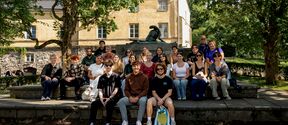To measure or not to measure? The basics of academic thinking provide students with problem-solving skills

It is Friday afternoon and the front of the lecture hall U8 at Aalto University’s Undergraduate Centre is teeming with students. The hustle and bustle has to do with Professor Sami Franssila’s course, Elementary academic thinking. The course is completed by means of lectures, group assignments and homework. Successful completion of the course requires active participation and the courage to try and err.
Now, at the start of October, first-year students have been tasked with building a tower as high as possible using corrugated cardboard and packing tape. The trick is that the tower has to withstand the weight of a petanque ball. The students have 20 minutes for planning and 40 minutes for building the tower. The highest tower wins, style points are not given.
‘The assignment tests creativity. When solving technical problems, there may be many correct answers, unlike in natural sciences where only one answer is right. It is typical that the number of questions and ideas at the start of a new project is high. However, most of the ideas are often not applicable. The towers we see here are very different but successful solutions nevertheless’, says Professor Sami Franssila who teaches the course.
‘Last year, we built boats using duct tape. The carrying capacity of the best boat was 20 times higher than that of the worst’, Franssila continues.
The result is similar today. The highest tower that withstood the petanque ball is three times as high as the lowest. The approaches varied from reinforced cylinders to different kinds of triangular structures. One group used the tape roll as part of the tower’s design.
‘The tape could have been used more. It’s a good material for reinforcement. For example, the tape could have been used for building functional support structures. That would have allowed using more cardboard for the upward structures’, Franssila states referring to the students’ towers.

The essential skill of measuring
One of the key aspects discussed on the course has to do with measuring. The students learn to understand the problems and concepts related to measurement. It is also essential to question the results and to ensure their reliability and accuracy.
Many measurement situations and problems also involve the experimenter’s dilemma.
‘If you’re doing something nobody has done before, how do you know the right answer?’
According to Franssila, lecture halls U8 and U9 at the Undergraduate Centre provide an excellent setting for implementing experimental and functional instruction. The rows of auditorium-style table groups enable the organisation of lecture, group work and even small-scale construction activities.
The course also aims at finding solutions to practical problems and places them in the framework of academic thinking. Among other things, the student groups have been tasked with determining how long they could cope with the goods and foodstuffs available at the local mini-market in the event of a crisis. Practical magnitude assessment was practised when the groups estimated the amounts of food and liquids at the store.
‘Only a few groups thought about food preservation, but at least some came up with the idea of salting the meats and drying the bread to make rusk’, Franssila says when providing the students with feedback on the assignment.
‘Only one group took account of sufficient vitamin C intake.’
Many of the course assignments require creativity and courage to experiment. The solutions have to be based on reality, and hasty solutions are not desirable. Students are required to justify their calculations and decisions right from the start. In fact, the skills of acquiring, assessing, valuating and questioning information distinguish academic thinking from everyday thought processes.

Read more news

“This hands-on approach is the absolute best way to learn” – Loyola University and Aalto University partnered for the sixth time
Isabel Towghi shares her experience from Aalto University Summer School.
Bring your child to work day 2025 at the Department of Applied Physics
The Department of Applied Physics encouraged employees to bring their children to work on 21. November 2025- you can have a peak at what kids did on that day
Aalto Mac: Network settings to be updated
Updates begin during Christmas time






